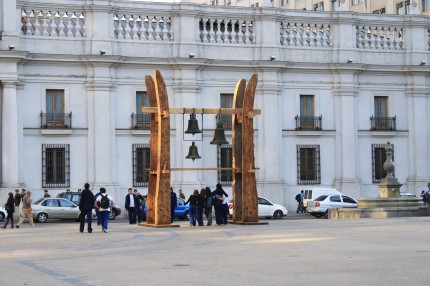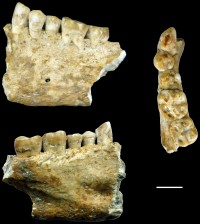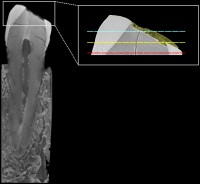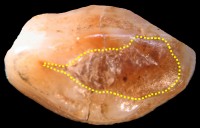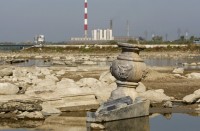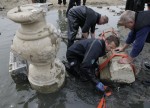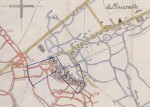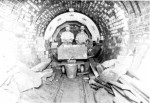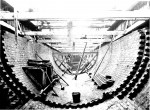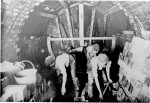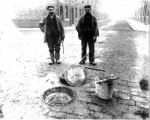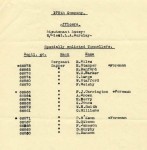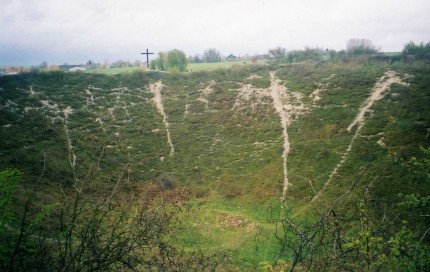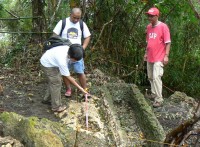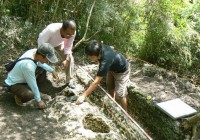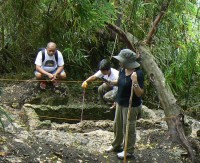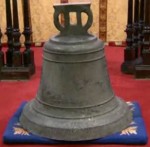 In a ceremony attended by the Archbishop of Wales, Prince Edward, the Earl of Wessex, and the Chilean ambassador on Monday, St. Thomas’s Church in Neath, Wales officially handed back a 260-year-old bell that was salvaged from a devastating 1863 church fire in Santiago, Chile. Before an honor guard of 20 volunteer Chilean firefighters, the Earl of Wessex, an honorary member of the fire brigade, formally received the bell in their name. It will be shipped back to Chile in the next few weeks.
In a ceremony attended by the Archbishop of Wales, Prince Edward, the Earl of Wessex, and the Chilean ambassador on Monday, St. Thomas’s Church in Neath, Wales officially handed back a 260-year-old bell that was salvaged from a devastating 1863 church fire in Santiago, Chile. Before an honor guard of 20 volunteer Chilean firefighters, the Earl of Wessex, an honorary member of the fire brigade, formally received the bell in their name. It will be shipped back to Chile in the next few weeks.
The bell had been at the church since 1870, but it was never hung in the tower and never rung. St. Thomas’s already had six bells in fine order when they received it as a gift from Swansea industrialist Graham Vivian, so they stored the Santiago bell next to the tower door at the back of the church and pretty much forgot about it. Last year, Canon Stephen J. Ryan, the Rector of the benefice (i.e., parish) of Neath, received a letter 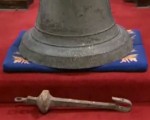 from the 14th Company of the British and Commonwealth Fire Company Foundation asking after the bell. The Foundation wasn’t sure exactly where, but they had information that one of the Santiago bells was in a Neath church and if that was the case, they asked that it be returned. The bell was located in St. Thomas’s, and experts from Chile traveled to the church to confirm its identity. All that was left was arranging the return in time for next year’s 150th anniversary of the tragedy.
from the 14th Company of the British and Commonwealth Fire Company Foundation asking after the bell. The Foundation wasn’t sure exactly where, but they had information that one of the Santiago bells was in a Neath church and if that was the case, they asked that it be returned. The bell was located in St. Thomas’s, and experts from Chile traveled to the church to confirm its identity. All that was left was arranging the return in time for next year’s 150th anniversary of the tragedy.
This long, strange journey began on the night of December 8th, 1863, in Santiago, Chile. The Church of the Company of Jesus, a Jesuit church in downtown Santiago, was celebrating the Feast of the Immaculate Conception, the culmination of the Month of Maria, a month-long festival dedicated to Mary, the mother of Christ. Don Juan Ugarte, the priest celebrant, had invited all the finest members of Santiago society to the final and most important mass of the month. He decorated the church with thousands of candles and paraffin lamps, draped curtains of muslin and gauze from the ceiling, and adorned all surfaces with ribbons and paper flowers.
 The church was packed to the gills with people, about 3000 congregants, most of them women. Shortly before 7:00 PM when the mass was set to begin, most of the doors were closed to keep people from wandering in and out and to ensure the priest could be heard well. All the lamps were lit. At the high altar, paraffin lamps were positioned behind a transparent crescent moon painting which served as the pedestal for a colossal statue of the Virgin Mary. As soon as they were lit the lamps ignited the crescent moon. One of the attendants tried to extinguish the fire with his poncho, but the garment was quickly imbued with the paraffin and became a conduit of flame.
The church was packed to the gills with people, about 3000 congregants, most of them women. Shortly before 7:00 PM when the mass was set to begin, most of the doors were closed to keep people from wandering in and out and to ensure the priest could be heard well. All the lamps were lit. At the high altar, paraffin lamps were positioned behind a transparent crescent moon painting which served as the pedestal for a colossal statue of the Virgin Mary. As soon as they were lit the lamps ignited the crescent moon. One of the attendants tried to extinguish the fire with his poncho, but the garment was quickly imbued with the paraffin and became a conduit of flame.
From there the fire spread to a wooden screen behind the altar, then along the artificial flower wreaths, then up the walls to the cupola. Lamps had been attached to the ceiling with ropes, so once the roof started to burn, the lamps plummeted to the crowd beneath, igniting clothes and hair and turning the floor of the church into a lake of fire. Three thousand people, many of them in hoop skirts, tried to run for the doors, only to find them closed except for the main entrance which was soon blocked by the crush of human bodies. The church and almost everyone in it burned to the ground in just over an hour.
 The U.S. Envoy to Chile, Thomas H. Nelson, American consul Henry Meiggs and cartographer George Woolworth Colton were among the first to the scene. They distinguished themselves by chopping down the closed doors and rushing into the inferno to rescue anyone they could find alive and to take out the bodies of the dead before the walls of flame became impassable. Only 500 or so people made it out alive. Of the approximately 2500 dead, only seven were identified. The rest were burned beyond recognition.
The U.S. Envoy to Chile, Thomas H. Nelson, American consul Henry Meiggs and cartographer George Woolworth Colton were among the first to the scene. They distinguished themselves by chopping down the closed doors and rushing into the inferno to rescue anyone they could find alive and to take out the bodies of the dead before the walls of flame became impassable. Only 500 or so people made it out alive. Of the approximately 2500 dead, only seven were identified. The rest were burned beyond recognition.
None of the priests died. They fled through a vestry door, closing it behind them so the valuable property in the vestry could be moved to safety before burning. The eye-witness account in the New York Times put it bluntly:
Certain it is, that three rooms in a neighboring palatial mansion are filled with furniture, carpets, curtains and pictures, saved from the vestry, while a few paces beyond were perishing, in frightful torture, hundreds of frail and helpless human beings, many of whom could have found safety through that door.
The cleanup of the bodies took ten days. All but the seven identifiable victims were buried in a mass grave in the General Cemetery of Santiago. The ruins of the church were demolished and a garden planted on the location in memory of the 2500 who lost their lives in one of the worst fires in history, probably the worst church fire in history.
It was this tragedy that spurred the creation of the first organized volunteer fire brigade in the city. One of the rescuers, José Luis Claro Cruz, placed an ad in the paper calling for volunteers three days after the fire. By December 20th, Santiago had a full complement of volunteer firefighters divided into four brigades. To this day Chile’s firefighting organizations remain staffed by volunteers.
 At least four bells of the church survived the fire. They were sold for scrap to Graham Vivian, grandson of the founder of a huge industrial copper smelting business in Swansea, Wales. By the time of the fire, Swansea was the copper capital of the world, producing 40% of the global output. It was dubbed Copperopolis and remained the leader in copper production until the US surpassed it in the late 19th century. Vivian & Sons, like many other Welsh copper concerns, collected ore from all over the world. Chile was one of their prime sources.
At least four bells of the church survived the fire. They were sold for scrap to Graham Vivian, grandson of the founder of a huge industrial copper smelting business in Swansea, Wales. By the time of the fire, Swansea was the copper capital of the world, producing 40% of the global output. It was dubbed Copperopolis and remained the leader in copper production until the US surpassed it in the late 19th century. Vivian & Sons, like many other Welsh copper concerns, collected ore from all over the world. Chile was one of their prime sources.
Vivian shipped the bells on a copper barque from Valparaiso to Swansea, but once they got there, he chose not to melt them down. They were high quality and of some age, cast in Spain in 1753 and decorated with religious iconography and inscriptions in Latin and Spanish. He presented three of the bells to All Saints Church in Oystermouth and one to St. Thomas’s in Neath. All Saints gave him some of their broken medieval bells in return and he melted those down instead.
 The Santiago bells at All Saints rang for almost a hundred years until structural issues in the bell tower made it dangerous for them to remain. They were taken down in 1964 and put on display in a metal brace on the porch. In October 2009, the Embassy of Chile in London wrote to All Saints asking if they’d consider returning the bells to Chile. The country was planning a number of events for its bicentennial on September 18th of that year, and they hoped the bells could play a part in them. They also wanted to create a new memorial to the victims of the tragedy using the bells.
The Santiago bells at All Saints rang for almost a hundred years until structural issues in the bell tower made it dangerous for them to remain. They were taken down in 1964 and put on display in a metal brace on the porch. In October 2009, the Embassy of Chile in London wrote to All Saints asking if they’d consider returning the bells to Chile. The country was planning a number of events for its bicentennial on September 18th of that year, and they hoped the bells could play a part in them. They also wanted to create a new memorial to the victims of the tragedy using the bells.
The parish decided to return the bells because it was the “right and Christian thing to do.” The three Santiago bells were back in Chile in time for the bicentennial. They are now hanging in a memorial to the victims in the Plaza de la Constitution. The St. Thomas bell will join them. Together the four bells will be rung again on special occasions.
